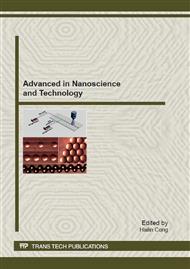[1]
T. Nonami, H. Hase, K. Funakoshi, Apatite-coated titanium dioxide photocatalyst for air purification, Catal. Today. 96 (2004)113-118.
DOI: 10.1016/j.cattod.2004.06.112
Google Scholar
[2]
S.D. Ji, S. Murakami, M. Kamitakahara, K. Ioku, Fabrication of titania/hydroxyapatite composite granules for photocatalyst, Mater. Res. Bull. 44 (2009) 768-774.
DOI: 10.1016/j.materresbull.2008.09.047
Google Scholar
[3]
H.F. Liu, X.N. Cheng, J. Yang, X.H. Yan, H.B. Shi, Preparation and characterization of nucleus/shell TiO2/HAP complex nanophotocatalyst, J. Mater. Sci. Technol. 23 (2007) 123-126.
Google Scholar
[4]
H. Nishikawa, A high active type of hydroxyapatite for photocatalytic decomposition of dimethyl sulfide under UV irradiation, J. Mol. Catal. A 207 (2004) 149-153.
DOI: 10.1016/s1381-1169(03)00472-2
Google Scholar
[5]
M.P. Reddy, A. Venugopal, M. Subrahmanyam, Hydroxyapatite photocatalytic degradation of calmagite (an azo dye) in aqueous suspension, Appl. Catal. B 69 (2006) 164-170.
DOI: 10.1016/j.apcatb.2006.07.003
Google Scholar
[6]
T. Nonami, H. Taoda, N.T. Hue, E. Wa tanabe, K. Iseda, M. Tazawa, M. Fukaya, Apatite formation on TiO2 photocatalyst film in a pseudo body solution, Mater. Res. Bull. 33 (1998) 125-131.
DOI: 10.1016/s0025-5408(97)00197-9
Google Scholar
[7]
H.W. Kim, Y.H. Koh, L.H. Li, S. Lee, H.E. Kim, Hydroxyapatite coating on titanium substrate with titania buffer layer processed by sol-gel method, Biomaterials 25 (2004) 2533-2538.
DOI: 10.1016/j.biomaterials.2003.09.041
Google Scholar
[8]
D.Y. Chen, E.H. Jordan, M. Gell, M. Wei, Alkaline induced apatite formation on solution precursor plasma spray dense TiO2 coatings, Acta Biomaterialia 4 (2008) 553-559.
DOI: 10.1016/j.actbio.2007.11.008
Google Scholar
[9]
F.Z. Shi, Q.H. Zhang, Y.G. Li, H.Z. Wang, Preparation and characterization of apatite coated rutile TiO2 composite powders, J. Inorg. Mater. 24 (2009) 893-896.
DOI: 10.3724/sp.j.1077.2009.00893
Google Scholar
[10]
T. Kasuga, H. Kondo, M. Nogami, Apatite formation on TiO2 in simulated body fluid, J. Cryst. Growth 235 (2002) 235-240.
DOI: 10.1016/s0022-0248(01)01782-1
Google Scholar
[11]
Q.H. Zhang, L. Gao, J.K. Guo, Effects of calcination on the photocatalytic properties of nanosized TiO2 powders prepared by TiCl4 hydrolysis, Appl. Catal. B 26 (2000) 207-215.
DOI: 10.1016/s0926-3373(00)00122-3
Google Scholar
[12]
C. Ohtsuki, H. Iida, S. Nakamura, A. Osaka, Bioactivity of titanium treated with hydrogen peroxide solutions containing metal chlorides, J. Biomed. Mater. Res. 35 (1997) 39-47.
DOI: 10.1002/(sici)1097-4636(199704)35:1<39::aid-jbm5>3.0.co;2-n
Google Scholar
[13]
J. Sun, L. Gao, Q.H. Zhang, Synthesizing and comparing the photocatalytic properties of high surface area rutile and anatase titania nanoparticles, J. Am. Ceram. Soc. 86 (2003) 1677-1682.
DOI: 10.1111/j.1151-2916.2003.tb03539.x
Google Scholar
[14]
M. Keshmiri, T. Trocrzynski, Apatite formation on TiO2 anatase microspheres, J. Non-Cryst. Solids 324 (2003) 289
DOI: 10.1016/s0022-3093(03)00363-6
Google Scholar
[15]
N. Balázs, K. Mogyorósi, D.F. Srankó, A. Pallagi, T. Alapi, A. Oszkó, A. Dombi, P. Sipos, The effect of particle shape on the activity of nanocrystalline TiO2 photocatalysts in phenol decomposition, Appl. Catal. B 84 (2008) 356-362.
DOI: 10.1016/j.apcatb.2008.04.018
Google Scholar
[16]
K. Cheng, S. Zhang, W.J. Weng, X.T. Zeng, The interfacial study of sol-gel derived fluoridated hydroxyapatite coatings, Sur. Coating Tech. 198 (2005) 242-246.
DOI: 10.1016/j.surfcoat.2004.10.024
Google Scholar
[17]
Z.P. Yang, S.H. Si, X.M. Zeng, C.J. Zhang, H.J. Dai, Mechanism and kinetics of apatite formation on nanocrystalline TiO2 coatings: a quartz crystal microbalance study, Acta Biomaterialia 4 (2008) 560-568.
DOI: 10.1016/j.actbio.2007.10.003
Google Scholar
[18]
H.M. Kim, T. Himeno, M. Kawashita, J.H. Lee, T. Kokubo, T. Nakamura, Surface potential change in bioactive titanium metal during the process of apatite formation in simulated body fluid, J. Biomed. Mater. Res. 67A (2003) 1305-1309.
DOI: 10.1002/jbm.a.20039
Google Scholar


